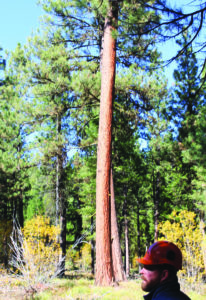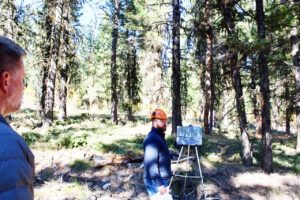
First county-administered fuels reduction project on national forest land
The Bitterroot National Forest (BNF) sponsored a media field trip last week to show off the results of the first fuels reduction project to be administered by Ravalli County on national forest land. Andrew Amidon, Ravalli County’s new forester who started working for the county last February, administered the project and conducted the review of the finished work. Ravalli County Commissioner Jeff Burrows and Bitterroot National Forest Supervisor Matthew Anderson were both present along with BNF fire management, silviculturist and administrative personnel, representatives of the timber industry, Bureau of Land Management, and other Montana resource managers.
The 130-acre Trapper-Bunkhouse Fuels Reduction project was a non-commercial thinning project done by hand lopping and scattering as well as hand stacking piles in thickly vegetated areas where there was too much simply to scatter and burn safely. In those areas, according to Forest Service Silviculturist Cheri Hartless who designed the thinning project, the piles will be burnt before the whole area is burned again in preparation for future logging in the area.
According to Hartless, the Forest Service began researching potential fuel reduction in the area stretching from the West Fork boundary all the way to Tin Cup Creek back in 2003. She said a lot of commercial thinning was conducted across the area, but a lot of the non-commercial thinning was not completed. This unit was one that was not treated and was so heavily overgrown that there was simply too much ladder fuels to even begin a prescribed fire which usually precedes a commercial thinning project. As a result, they went in and piled slash by hand.
“That makes this sort of a middle treatment in the process,” said Hartless. “We will burn the piles and then come back and do a full under burn before coming in and doing the required commercial thinning.”

The commercial thinning is designed to take the forest back to a Ponderosa Pine dominated forest, but not a monoculture, according to Hartless. She said historically mature Ponderosa Pine forests were covered about 80% in Ponderosa Pine and about 20% in Douglas Fir. Due to decades of fire suppression on the forest, however, the ratio has reversed itself. She said that Ponderosa Pines need disturbance, like wildland fires, to proliferate, but Douglas Fir trees do well in undisturbed soils. As a result, over years, the ratio has been flipped on its head so the forest is made up of only 20% Ponderosa Pine and about 80% Douglas Fir.
Commissioner Burrows said he was happy to be working together with the Forest Service on this type of project. He said it has been a frustrating situation as high hazard areas for wildfires are identified, analyzed and re-analyzed, and then litigated and before any action can be taken the forest burns up.
“These people fearful of large scale landscape projects like that proposed on the Bitterroot Front need to look at the big picture,” said Burrows. “If you consider the wilderness areas and the wilderness study areas, it’s just a pretty small fraction of the forest that we can do things on. A small fraction of the area has been identified as high fire hazard and it is important to do something about it,” he said. “I think it’s urgent that we increase the pace and scale of work. I think it’s urgent for the protection of private and public lands that we get this work done. I’d like to see this project on steroids basically. Just keep going and get work done. That’s our interest from the County level.”
Burrows said it would help if the pay related to pro-active projects like this were equal to the pay given out for emergency suppression efforts.
BNF Supervisor Matthew Anderson said that the Forest Service was very happy to have the help and was working hard on making this paradigm shift in forest management and making some changes in the funding mechanisms that could help make these kinds of cooperative projects feasible.

Worried about the future says
Very odd. The Forest Service used to say they must commercially log in order to make it possible to introduce fire to the landscape. Now it seems they are slashing and burning and then burning again to then commercially log all of that fragile burned soil.